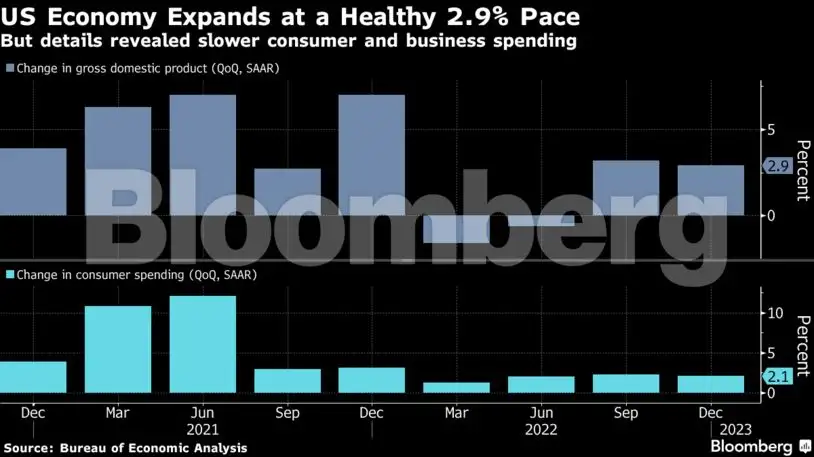Policymakers from Hungary to Chile left interest rates unchanged this week, while the Bank of Canada signaled it may soon pause to assess the impact of policy thus far. Officials in South Africa and Colombia downshifted to smaller hikes amid risks to growth.
In the US, the Federal Reserve’s key inflation gauges ebbed in December to the slowest annual paces since late 2021. Measures of wholesale inflation fell in some European countries last month, including Finland and Slovakia.
Here are some of the charts that appeared on Bloomberg this week on the latest developments in the global economy:
World
 Bloomberg
BloombergColombia surprised most analysts by slowing the pace of monetary tightening as the economy shows signs of a sharp slowdown, while the Bank of Canada raised interest rates for an eighth consecutive and potentially final time. Hungary, Sri Lanka, Paraguay, Ukraine and Chile stood pat, while Pakistan, Nigeria, Thailand and South Africa kept hiking.
 Bloomberg
BloombergCentral bankers trying to ensure that surging consumer prices don’t feed yet more inflation are doing what they can to keep their own houses in order. For staff working for US Fed Chair Jerome Powell, his euro-zone counterpart Christine Lagarde and their global peers, annual pay adjustments can’t avoid the impact of a once-in-a-generation cost-of-living shock.US & Canada
 Bloomberg
BloombergThe Fed’s preferred inflation measures eased in December to the slowest annual paces in over a year while consumer spending fell, helping pave the way for officials to further scale back the pace of interest-rate hikes.
 Bloomberg
BloombergThe economy beat expectations in the last quarter of 2022, posting the kind of mild slowdown that the Fed wants to see as it attempts to tame inflation without choking off growth. Economists who dug into the details, though, saw enough warning signs – especially in weakening demand among consumers – to suggest that a recession remains a big risk this year.
 Bloomberg
BloombergHousing costs, and Canada’s unique way of capturing them in inflation, suggest that consumer price gains may slow rapidly in coming months.
Emerging Markets
 Bloomberg
BloombergBrazil’s annual inflation eased slightly for the eighth-straight month on smaller rises in transportation and housing costs as the central bank holds its interest rate high. Still, the architect of the inflation-targeting regime said the goals of 3.25% for 2023 and 3% for next year are far too low.
 Bloomberg
BloombergChile’s central bank President Rosanna Costa is pushing back against bets that policymakers will start a series of steep interest-rate cuts in April. Inflation remains “extraordinarily high” and the bank needs more time to ensure it’s slowing toward the target before it can ease monetary policy, Costa said in a Bloomberg Television interview, after policymakers decided to hold rates at 11.25% for a second-straight meeting.
Europe
 Bloomberg
BloombergThe private-sector economy in the euro area unexpectedly returned to growth at the start of 2023, offering further signs the region may avoid a recession. A variety of factors including slowing inflation, a warmer-than-usual winter in energy-strapped Europe and an easing of supply-chain constraints are fanning optimism in the 20-member currency zone.
 Bloomberg
BloombergThe UK government sank deeper into debt in December as rising debt-interest payments and the cost of insulating consumers and businesses from the energy-price shock strained the public finances. The budget deficit stood at £27.4 billion ($34 billion), a record for the month and almost triple the £10.7 billion shortfall a year earlier.
Asia
 Bloomberg
BloombergJapan continues to predict it can balance its budget in the year starting April 2026 under a high-growth scenario, despite plans to ramp up defense spending over the coming years.
 Bloomberg
BloombergIndia’s economic transformation is kicking into high gear. The government is spending nearly 20% of its budget this fiscal year on capital investments, the most in at least a decade. Prime Minister Narendra Modi is closer than any predecessor to being able to claim that the nation — which may have just passed China as the world’s most populous — is finally meeting its economic potential.
–With assistance from Philip Aldrick, Vrishti Beniwal, Enda Curran, Matthew Malinowski, Jana Randow, Tom Rees, Isabel Reynolds, Andrew Rosati, Augusta Saraiva, Zoe Schneeweiss, Kai Schultz, Yuko Takeo and Randy Thanthong-Knight.







